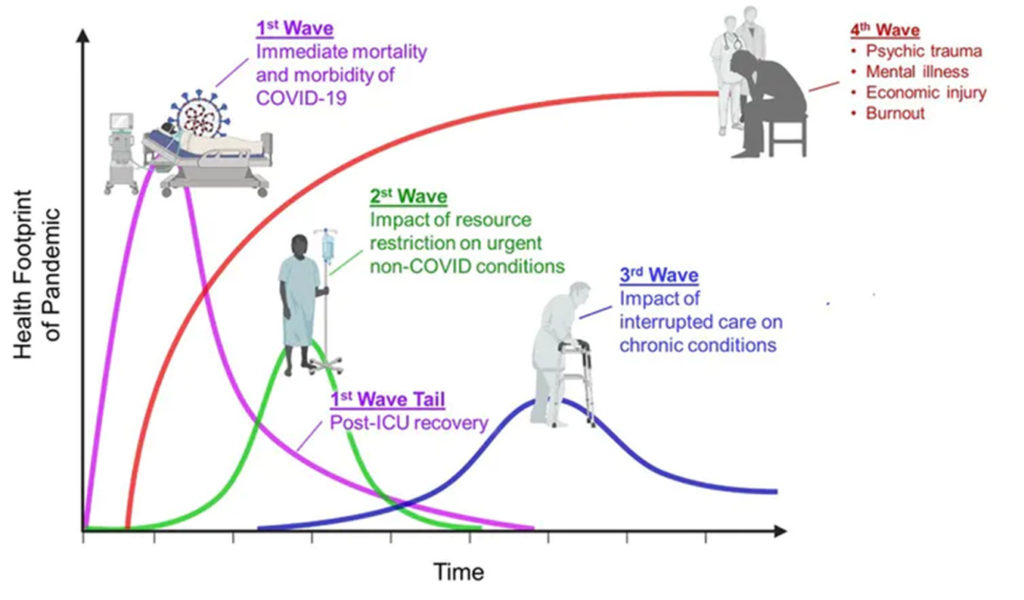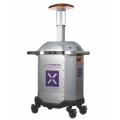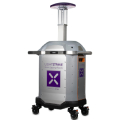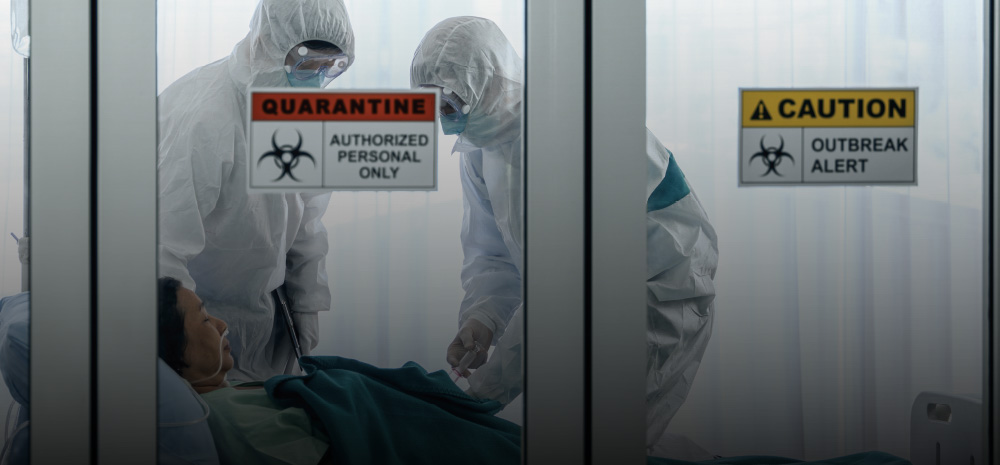Despite major advances in medical science, pathogens (bacteria, viruses, fungi, parasites) remain a significant source of illness and death in the United States [1]. Pathogens can cause pandemics or outbreaks that are spread across countries. Pandemics are more likely to happen due to zoonotic spillover (pathogens jump from animal to human), the emergence of new pathogens (COVID-19), urbanization and globalization, pandemic influenza, and the growing problem of antimicrobial resistance [1]. The collateral damage caused by pandemics can be explained by the four waves.

Image: Dr. Victor Tseng, link to original: https://twitter.com/vectorsting/status/1244671755781898241
Wave 1: Mortality and Morbidity
The 1st wave is the immediate mortality and morbidity. Pandemics are characterized by their high death toll and health problems associated with experiencing the disease. The Black Death pandemic (1347 to 1351) came in successive waves through Europe, Asia, and the Middle East killing an estimated 75-200 million people [2]. Doctors at the time tried to cure plague victims using traditional methods such as bloodletting and clearing bad air from the home [2]. Influenza viruses have caused several deadly pandemics throughout history, and they continue to cause yearly epidemics during flu season. The 1918 Influenza pandemic killed 675,000 people in the United States, many of which were 18 to 40 years old [3]. From 1918-1920, influenza swept through American cities so quickly that morgues were overflowing, and bodies were piled up in the streets [3]. During the most recent 2018-19 flu season, an estimated 35.5 million Americans fell ill with the flu and 35,000 died [4]. The yearly cost of influenza epidemics is estimated to be $500 billion (0.6 person of global income) from lost income and the intrinsic cost of mortality [5]. The current COVID-19 pandemic is still not over, with almost 23 million infections and 400,000 deaths in the United States [6]. Sadly, over 3,100 healthcare workers have lost their lives to COVID-19. Lost on the Frontline is a database that aims to count and honor the healthcare workers (physicians, custodians, paramedics, etc.) who died after contracting coronavirus while on the job: https://www.theguardian.com/us-news/ng-interactive/2020/aug/11/lost-on-the-frontline-covid-19-coronavirus-us-healthcare-workers-deaths-database
Wave 2: Health Care System Capacity
The 2nd wave of a pandemic is the lack of resources for patients with emergencies who cannot get urgent care due to stretched health care capacity. The 1918 Influenza pandemic overwhelmed health care services in the United States [7]. There were not enough physicians, nurses, support staff, or beds for influenza patients [7]. More than one third of doctors, and even more nurses, were serving overseas in World War I [7,8]. Volunteers and retired physicians and nurses stepped in to provide supportive care for influenza patients [7,8]. Medical and nursing schools graduated students early so they could make up staffing shortages [7,8]. Many cities and towns had to turn gymnasiums, state armories, and parish halls into patient wards [7,8]. Medical supplies such as bed linens, bed pans, and hospital gowns were also in short supply. The COVID-19 pandemic has seen many of the same issues with health care systems reaching capacity, especially in rural areas where 172 hospitals have closed since 2005 [9]. Pandemics increase hospitalizations and strain health systems resources and capacity to provide emergency or routine care to patients. The University of Minnesota COVID-19 Hospitalization Tracking Project provides information on the current hospital capacity for each county in the United States: https://carlsonschool.umn.edu/mili-misrc-covid19-tracking-project
Wave 3: Interrupted or Delayed Care
The 3rd wave of a pandemic is the potential harm and consequences of interrupted or delayed care due to the health system capacity or resources. Patients with chronic conditions whose care is interrupted or delayed can experience significant complications or even death. There is recent research showing that states with the highest COVID-19 deaths also experienced increased numbers of deaths from heart disease, diabetes, stroke, and cancer [10]. One survey found that over 25% of respondents postponed or skipped care and subsequently experienced a worsening of their medical condition [11]. The pandemic has also caused massive unemployment, with millions of Americans losing work and health insurance coverage [12]. This will likely increase the number of people that have to interrupt care or delay care due to the inability to pay [12]. The number of preventative cancer screenings and newly diagnosed cancers has also declined substantially since the onset of the COVID-19 pandemic, and they have yet to be back to pre-pandemic levels [13]. Researchers estimate that over the next ten years there could be nearly 10,000 excess breast and colorectal cancer deaths due to the negative impact of the pandemic on cancer screening and treatment [13].
Wave 4: Long-term Consequences
The 4th wave of a pandemic is the long-term mental health and economic injury from surviving a global pandemic. The 4th wave takes years to see the full impact. An analysis of 65,354 patients recovered from COVID-19 found that 20% of them developed a mental health problem such as depression, anxiety, or dementia within three months of diagnosis [14]. Healthcare workers taking care of COVID-19 patients have reported considerable stress, anxiety, depression, and insomnia [15]. The 1918 Influenza pandemic was especially deadly among working age males in the United States, which had serious economic consequences for the families left without a breadwinner and businesses without workers [3]. Research suggests that the pandemic caused major reductions in human capital (collective resources possessed by individuals and groups) for people born during that time, which had important implications on subsequent economic activity in the years following the pandemic [3]. Pandemics can have their silver linings. Scholars argue that the Black Death broke down the feudal caste system and pushed Europe into the Renaissance era [2]. The 1918 Influenza pandemic spurred the United States and many other nations to develop influenza surveillance systems, diagnostics, antivirals, and influenza vaccines [8].
The pandemic has prompted many individuals and organizations to pay more attention to infection prevention and control practices and policies. Pandemics cause enormous human suffering and economic hardship; however, they can be prevented by stopping zoonotic spillover, containing the emergence of new pathogens, increasing influenza vaccine adoption, and combatting antimicrobial resistant pathogens. Every infection prevented, is one less person that can spread infection to their environment and others.
Author: Deborah Passey, Ph.D
References
1. National Academies of Sciences, Engineering, and Medicine; Health and Medicine Division; Board on Global Health; Committee on Global Health and the Future of the United States. Global Health and the Future Role of the United States. Washington (DC): National Academies Press (US); 2017 May 15. 3, Infectious Diseases, Pandemic Influenza, and Antimicrobial Resistance: Global Health Security Is National Security. Available from: https://www.ncbi.nlm.nih.gov/books/NBK458470/
2. Cartwright M. Black Death. Ancient History Encyclopedia. Mar 2020. Retrieved from: https://www.ancient.eu/Black_Death/
3. Garrett TA. Pandemic economics: The 1918 influenza and its modern-day implications. Federal Reserve Bank of St. Louis Review. 2008 Mar 3;90(March/April 2008).
4. Centers for Disease Control and Prevention. Estimated influenza illnesses, medical visits, hospitalizations, and deaths in the United States-2018-2019 influenza season. https://www.cdc.gov/flu/about/burden/2018-2019.html
5. Bloom DE, Cadarette D, and Sevilla JP. Epidemics and Economics. Finance & Development. 2018 Jun 55;2. Retrieved from: https://www.imf.org/external/pubs/ft/fandd/2018/06/economic-risks-and-impacts-of-epidemics/bloom.pdf
6. Johns Hopkins University, Coronavirus Map. Retrieved from: https://coronavirus.jhu.edu/us-map
7. Schoch-Spana M. ” Hospital’s full-up”: the 1918 influenza pandemic. Public Health Reports. 2001;116(Suppl 2):32.
8. Jester BJ, Uyeki TM, Patel A, Koonin L, Jernigan DB. 100 Years of medical countermeasures and pandemic influenza preparedness. American journal of public health. 2018 Nov;108(11):1469-72.
9. University of Pennsylvania, Leonard Davis Institute of Health Economics, Virtual Seminar: Rural Health in America During COVID-19 A Conversation with Lisa Davis, Mark Holmes, Cara James, and Karen Murphy. May 2020 Retrieved from: https://ldi.upenn.edu/event/virtual-seminar-rural-health-america-during-covid-19
10. Woolf SH, Chapman DA, Sabo RT, Weinberger DM, Hill L. Excess deaths from COVID-19 and other causes, March-April 2020. Jama. 2020 Aug 4;324(5):510-3.
11. Czeisler MÉ, Marynak K, Clarke KE, et al. Delay or Avoidance of Medical Care Because of COVID-19–Related Concerns — United States, June 2020. MMWR Morb Mortal Wkly Rep 2020;69:1250–1257. DOI: http://dx.doi.org/10.15585/mmwr.mm6936a4
12. Chen J and McGeorge R. Spillover Effects Of The COVID-19 Pandemic Could Drive Long-Term Health Consequences For Non-COVID-19 Patients. Health Affairs Blog, October 2020. Retrieved from: https://www.healthaffairs.org/do/10.1377/hblog20201020.566558/full/
13. Sharpless NE. COVID-19 and cancer. Science. 2020:1290.
14. Taquet M, Luciano S, Geddes JR, Harrison PJ. Bidirectional associations between COVID-19 and psychiatric disorder: retrospective cohort studies of 62 354 COVID-19 cases in the USA. The Lancet Psychiatry. 2020 Nov 9.
15. Spoorthy MS, Pratapa SK, Mahant S. Mental health problems faced by healthcare workers due to the COVID-19 pandemic–A review. Asian journal of psychiatry. 2020 Jun 1;51:102119.
16. CDC. Antibiotic Resistance Threats in the United States, 2019. Atlanta, GA: U.S. Department of Health and Human Services, CDC; 2019.

















